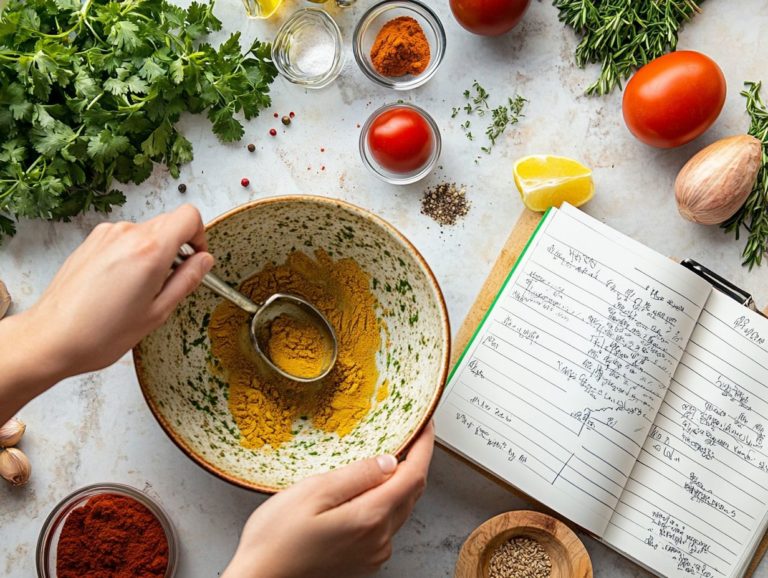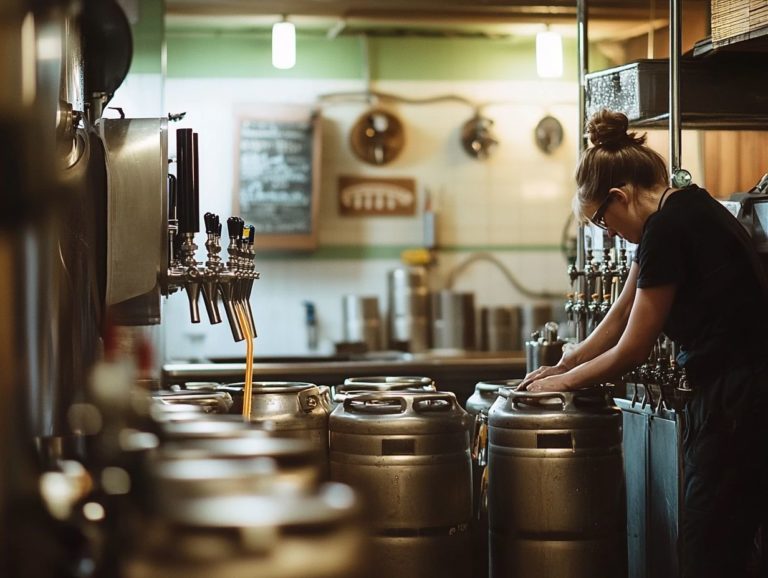What Is the Importance of Timing in Brewing?
Timing stands as a pivotal element in the brewing process, shaping everything from the flavor profiles to the overall quality of your final batch of beer.
Grasping how timing influences mashing, boiling, fermentation, and conditioning can truly elevate your craft brewing to new heights.
This article delves into the importance of timing in brewing, the various factors that can impact it, and offers valuable tips to ensure each batch of beer reaches its fullest potential.
Dive into these insights and discover how mastering timing can elevate your brewing adventures!
Contents
- Key Takeaways:
- The Brewing Process
- The Importance of Timing in Brewing
- The Brewing Process and Timing
- Factors That Affect Timing in Brewing
- 1. Type of Brewing Method and Techniques
- 2. Type of Ingredients Used
- Tips for Perfect Timing in Brewing Science
- Brewing Techniques: Practice and Experimentation
- Frequently Asked Questions
- What Is the Importance of Timing in Craft Brewing?
- How does the timing of mashing affect the brewing process?
- Why is it important to keep a consistent boil time during brewing?
- Does the timing of adding hops affect the taste of the beer?
- How Does the Timing of Fermentation Affect the Alcohol Content of Beer?
- What Is the Importance of Timing When Bottling or Kegging Beer?
Key Takeaways:
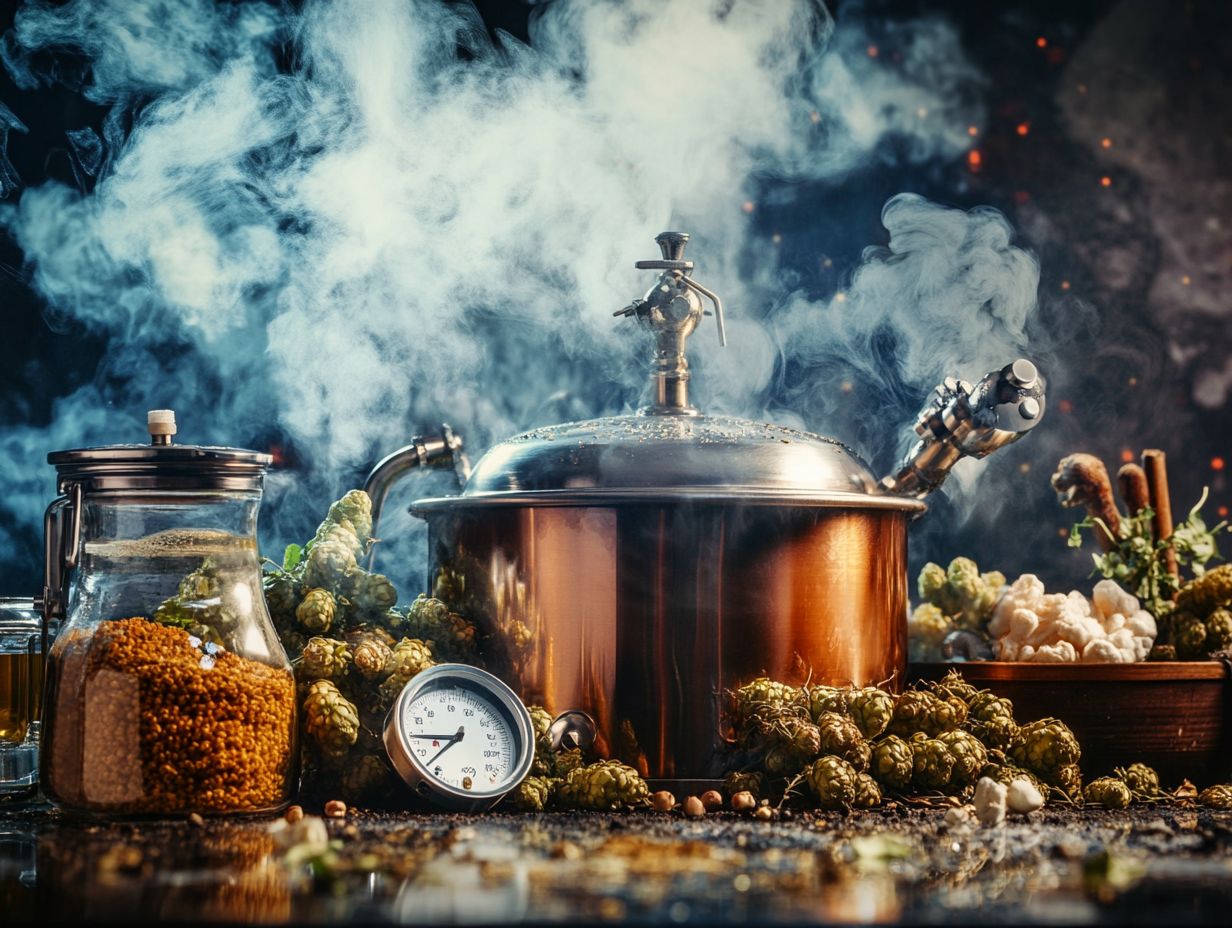
The Brewing Process
What Is Brewing?
Brewing is not just a process; it s a blend of creativity and technique dedicated to crafting beer.
This beloved beverage is known for its remarkable flavors and cultural significance that stretches back to the Ancient Sumerians.
In this delightful endeavor, you ll work with essential components: malt, water, hops, and yeast. Each element interacts through various brewing techniques, allowing you to achieve the flavor profile you desire.
Mastering the science of brewing is crucial, whether you’re a homebrewer or a professional, as it demands precise control over temperature, timing, and ingredient ratios to consistently create high-quality beer.
As brewing practices evolved, different regions developed unique techniques using local ingredients. The introduction of malt extract revolutionized the brewing process, enhancing consistency and accessibility, and broadening beer’s appeal.
Renowned brewing hubs have emerged worldwide, with trailblazers like Ron and Matteo Lahm leading the craft brewing movement, emphasizing quality and innovative flavors.
Fermentation is where the magic truly happens; it s the stage that transforms sugars into alcohol and CO2, enriching the complexity of flavors in your beer.
Each ingredient be it the aromatic hops or the meticulously chosen yeasts plays a vital role in shaping the final product, weaving together a rich tapestry of flavors that continues to enchant beer enthusiasts everywhere.
The Importance of Timing in Brewing
In brewing, timing is crucial. It can elevate or ruin a batch of beer, whether it’s a bold Double IPA or a refreshing Pilsner. Proper timing is essential for ensuring that each phase of the brewing process mashing, boiling, fermentation, and aging transpires at just the right moment.
This meticulous attention to timing results in the perfect balance of alcohol content and flavor profiles. By mastering these nuances, you position yourself to consistently create exceptional brews that truly captivate the senses. You’ll be amazed by how the perfect timing can transform your beer into a memorable experience.
Why Is Timing Important in Brewing?
Timing in brewing is absolutely crucial for you to control the flavors and alcohol content of your final product. Even the slightest deviation can lead to significant changes in taste and quality.
For example, the duration of the mash affects how much sugar you extract from the malt, which directly influences both the alcohol by volume (ABV) a measure of the amount of alcohol in your beer and the residual sugar levels in your beer.
The timing of hop additions during the boil also plays a critical role in determining the bitterness and aroma, underscoring the need for precision throughout your brewing process.
Fermentation timing is equally important for developing that desired flavor profile. A rapid fermentation might result in the production of compounds like esters and phenols, which can create delightful fruity or spicy notes. Meanwhile, a slower fermentation can enhance complexity, leading to smoother taste profiles that are truly satisfying.
Regardless of whether you choose a traditional or modern brewing method, you’ll need to monitor these stages carefully to achieve a balanced final product. By mastering the timing across all stages mashing, boiling, and fermenting you can effectively manipulate the characteristics of your beer, resulting in a unique and harmonious brew that stands out.
How Does Timing Affect the Flavor of the Brew?
The impact of timing on the flavor of beer is profound; every minute matters during key processes like boiling and fermentation. Take hop additions, for instance. The timing here is crucial early additions ramp up the bitterness thanks to the process that makes hops bitter, while late additions are all about enhancing that delightful hop aroma.
Your fermentation timeline also plays a significant role; it affects the yeast’s performance, which in turn influences the beer’s pH and overall flavor complexity.
When you select different hops, each boasting its unique flavor profile, the timing effect becomes even more pronounced. Hops like Citra or Mosaic, when added late in the boil or during dry hopping, bring vibrant citrus and tropical notes to your brew. On the other hand, varieties such as Centennial offer a more balanced floral and pine characteristic, enriching the overall experience.
The duration of fermentation is critical in achieving that crystal-clear clarity and inviting mouthfeel you crave. Longer fermentation allows yeast sediment to settle while developing those natural by-products that add depth to the flavor.
Mastering and controlling these timing elements is essential for crafting an exceptional final product that truly showcases your unique brewing style.
The Brewing Process and Timing
The brewing process unfolds as a delicate dance of timing and technique, featuring essential steps like mashing, boiling, fermentation, and conditioning each demanding your precise attention to guarantee a successful outcome.
Your journey begins with mashing, where you combine malted grains with water to extract those coveted sugars. Then comes the boiling stage, where you introduce hops to develop bitterness and aroma that will elevate your brew.
Following the boil, fermentation takes center stage, allowing yeast to work its magic by converting sugars into alcohol. Finally, you enter the conditioning phase, where the beer matures, refining its clarity and enhancing its flavors, leading you to a truly exceptional brew.
1. Mashing
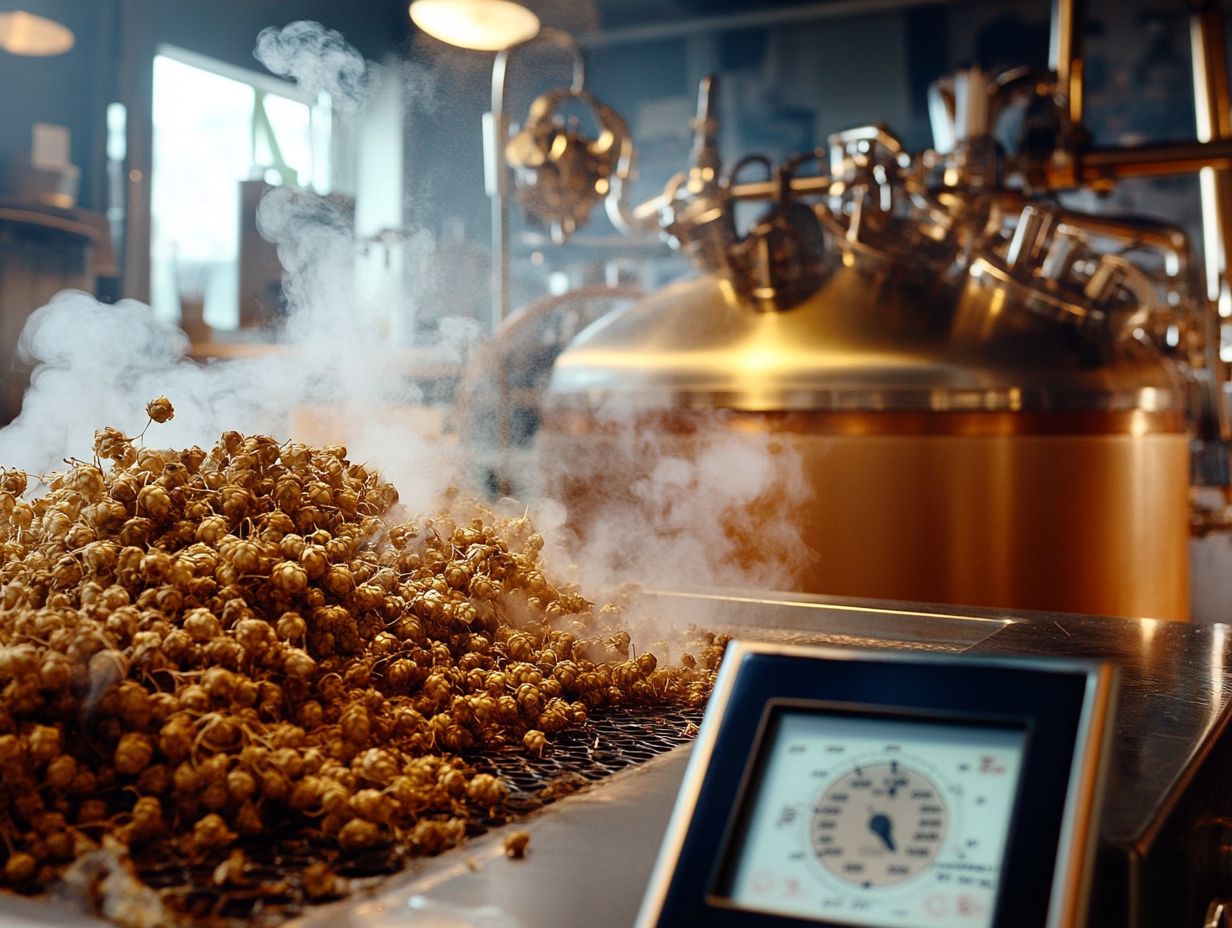
Mashing is the first crucial step in brewing. Here, you mix malted grains with warm water at exact temperatures to activate enzymes that convert starches into fermentable sugars.
This stage sets the foundation for the beer’s flavor profile. The sugar extracted here directly affects your brew’s alcohol content and mouthfeel.
Maintain a consistent temperature throughout mashing to optimize sugar extraction and prevent off-flavors. Typical temperature ranges are 145 F to 158 F (63 C to 70 C), depending on your desired beer style.
Stir the mash to ensure even heat and boost enzyme activity. Timing is also essential, lasting between 60 to 90 minutes. This gives the enzymes plenty of time to work their magic!
2. Boiling
The boiling stage is where you elevate the wort to a strong boil, creating the perfect opportunity to introduce hops that will impart both bitterness and flavor to your beer. Timing is essential in this phase; different hop varieties and their addition times can dramatically shift the bitterness level and aroma profile of your final product.
This boiling process not only helps eliminate undesirable compounds like Dimethyl Sulfide (DMS), ensuring a clean and crisp beer, but it also sterilizes the wort in preparation for fermentation.
For instance, when you add hops late typically during the last 15 minutes of the boil or even after you ve turned off the flame you can enhance the aromatic qualities, delivering a delightful burst of floral and citrus notes. On the other hand, earlier hop additions primarily build the bitterness, establishing the fundamental flavor profile of your brew.
Maintaining a consistent boil temperature is crucial; any fluctuations could hinder the evaporation of DMS, leading to off-flavors that could sabotage your brewing efforts. Therefore, by paying close attention to timing and temperature, you not only influence the taste but also safeguard the overall integrity of your brew.
3. Fermentation
Fermentation reactions are critical to the brewing process, which transforms the wort into beer. This stage involves complex biochemical processes driven by yeast. Yeast consumes the fermentable sugars in the wort, producing alcohol and carbon dioxide, and fundamentally altering the character of your beer.
Timing is everything in fermentation, and temperature control is essential for optimizing yeast activity. This influences both the clarity and flavor profile of your brew. Different yeast strains will produce a variety of flavor compounds. The duration of fermentation can significantly impact the final taste, aroma, and overall stability of the beer, including the overall alcohol by volume (ABV), which indicates the strength of your beer.
Temperature plays a pivotal role in this process. Raising the temperature can speed up yeast activity, but if things get too hot, you risk stressing the yeast, which can lead to unwanted off-flavors. On the other hand, lower temperatures can slow down fermentation, allowing for a more controlled and refined profile to develop over an extended period.
Closely monitoring fermentation is critical, as any fluctuations can create inconsistencies that compromise the quality of your final product. By understanding these dynamics, you can make informed adjustments, ensuring that each batch meets your aspirations for flavor, aroma, and overall drinkability.
4. Conditioning: The Final Step in Brewing
Conditioning marks the final step in the brewing process. Here, you allow the beer to mature, developing its flavors and achieving the desired clarity and stability before packaging. This crucial phase facilitates the seamless integration of flavors and may involve additional aging or carbonation adjustments tailored to the specific beer style.
The timing of conditioning is of utmost importance, as it significantly influences the mouthfeel and overall taste of the final product. This ensures a well-rounded and enjoyable experience for you and other drinkers.
During this stage, you might explore various aging techniques, such as barrel-aging, which can impart unique characteristics, or cold conditioning, which works wonders for enhancing clarity and stability. Each method plays a vital role in flavor development. For instance, barrel-aging introduces subtle tannins and rich notes from the wood, while colder temperatures promote sedimentation and a clearer presentation.
Understanding the impact of pH and residual sugar levels is crucial for successful conditioning. To determine when your beer is ready for packaging, you typically assess key aspects like aroma, taste, and visual clarity. These indicators will tell you exactly when to capture those flavors at their peak!
Factors That Affect Timing in Brewing
Several factors will influence the timing of each stage in your brewing process, ultimately impacting the quality and characteristics of the beer you produce. The choice of brewing method whether you opt for a traditional approach or embrace modern techniques will dictate the time required for each step.
Furthermore, the specific ingredients you select, including the type of malt and hops, alongside environmental considerations such as altitude and climate, may necessitate adjustments in timing. Don’t overlook the importance of the equipment and tools you use; they also play a crucial role in achieving optimal brewing times.
1. Type of Brewing Method and Techniques
The brewing method you choose dramatically influences your beer s timing and flavor. Traditional techniques take more time for mashing and fermentation compared to modern approaches.
For example, using specific hop aromas or products can enhance brewing efficiency. As a craft brewing enthusiast, you might experiment with various methods to create distinct flavor profiles.
Streamlined processes significantly reduce overall brew time without compromising quality. Grasping how these methods interact with fermentation reactions is essential for developing consistent styles and flavors.
Take all-grain brewing, for instance. This method offers greater control over the beer’s flavor and body, but it comes with a more demanding timeline due to the intricate mashing process, which is the process of soaking the grain to convert starches into sugars, and extended boiling times.
This method also affects how flavors and proteins are extracted from the grain, contributing to the overall beer profile. On the other hand, extract brewing simplifies the journey, enabling rapid production cycles that still yield impressive results.
This method often involves using malt extract, reducing the time and complexity associated with mashing. Recent innovations in craft brewing like hop oils or modern fermentation technologies such as controlled temperature fermenters enhance efficiency.
These advancements not only accelerate the brewing timeline but also maintain or even elevate desired flavors. For example, using products like LUPOMAX can ensure a more consistent hop flavor without extensive dry-hopping.
In the world of brewing, it s clear that time and quality can indeed coexist harmoniously.
2. Type of Ingredients Used
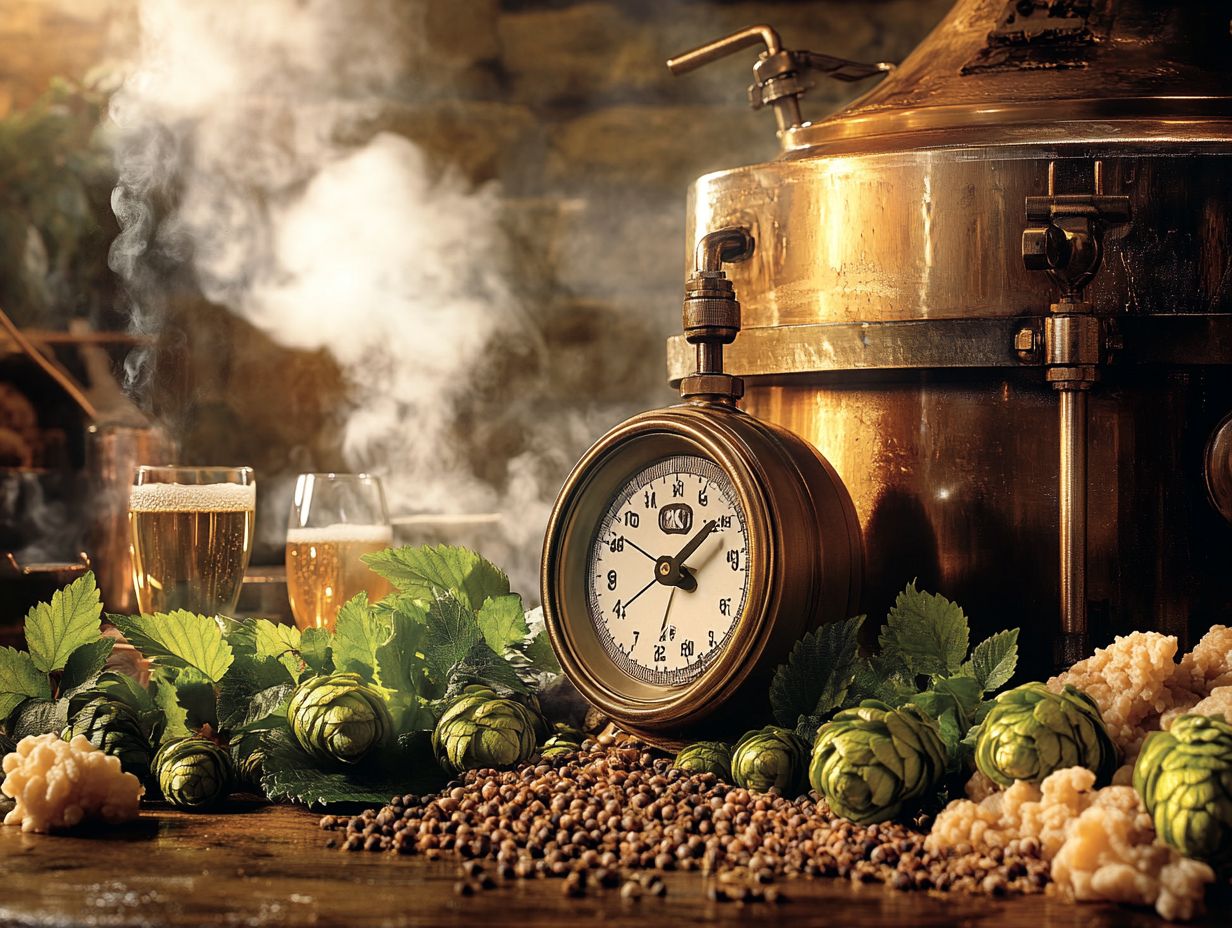
The type and quality of the ingredients you choose for brewing are crucial factors that influence timing. Different malts and hop varieties come with unique characteristics that require specific handling.
For instance, specialty malts may demand longer mashing times to fully extract their flavors. Certain hop products can also significantly alter boiling times and bitterness levels.
Your choice of yeast strains impacts fermentation duration and temperature management, shaping the overall beer profile that arises from your brewing process. Factors like the pH of the brewing water and the presence of chemicals such as DMS (Dimethyl Sulfide) can also influence the final product.
These nuances in ingredient selection dictate the efficiency of each step and play a pivotal role in achieving your desired flavor profile. For example, using crystal malts can infuse rich caramel notes, requiring adjustments in mashing duration for a well-rounded taste.
Conversely, an aggressive hopping schedule with aromatic varieties requires diligent monitoring during both the boil and dry-hopping phases to maximize hop character without tipping the balance. Some brewers even experiment with ancient grains used by the Ancient Sumerians to create unique flavors.
Your choice of specific yeast strains can enhance or mute certain flavors, making this selection vital in crafting a brew that aligns with your specifications. Selecting yeast that fits the brewing environment can assist in achieving consistent results.
Understanding these elements will not only refine your brewing technique but also inspire your next great beer adventure!
3. Altitude and Climate in Brewing
Altitude and climate are pivotal players in your brewing journey, influencing everything from temperatures to fermentation rates, and ultimately shaping the timing of each step. At higher altitudes, you’ll notice that water boils at lower temperatures, which means you may need to adjust your boiling times and temperatures to get it just right. Similarly, the ambient temperature can sway yeast activity during fermentation, prompting you to tailor your timing strategies according to the specific climate conditions you re working with. Understanding the impact of these variables on pH and the extraction of flavors is also essential.
For example, if you’re brewing in a high-altitude area, you might extend the boiling process to achieve a more profound extraction of flavors. Keep an eye on the evaporation rate that tends to spike with altitude.
If you’re in a warmer climate, fermentation may speed up too quickly, nudging you to lower the temperature or shorten fermentation times to dodge any unwanted off-flavors. Brewing centers, such as Oregon State University, have been instrumental in researching these impacts, providing valuable insights for brewers at varying altitudes.
Some craft breweries have even embraced temperature-controlled fermentation tanks to counteract the impacts of extreme climate conditions and uphold the consistency of their beer quality. This type of innovation is critical for maintaining the intended flavor profiles despite environmental variations.
4. Essential Equipment and Tools for Brewing
The equipment and tools you choose for brewing can significantly influence your timing and efficiency, affecting everything from mash temperature control to fermentation conditions. By investing in advanced brewing systems like those from John I. Haas, you can achieve precise temperature management, which not only shortens brewing times but also enhances the consistency and quality of your beer.
On the other hand, relying on traditional or less sophisticated equipment may extend the duration required to reach similar results, highlighting the very important nature of selecting the right tools for your desired brewing outcome. Equipment like the Rocket Giotto espresso machine has set a high standard for precision and quality, inspiring similar improvements in brewing technology.
As you explore the diverse array of brewing setups, choose your fermentation vessels wisely; they can make or break your brewing timeline. Fermenters designed to regulate temperature can boost yeast activity, facilitating a quicker transformation from wort to beer. Similarly, mash tuns featuring efficient insulation or advanced heating elements can optimize the mash process, minimizing energy consumption and reducing delays. Breweries equipped with advanced tools like the Acaia Lunar scale have improved the accuracy of ingredient measurements, further refining the brewing process.
Ultimately, your selection of brewing equipment has a direct correlation with the efficiency of your entire brewing endeavor, ensuring that each phase progresses smoothly without unnecessary setbacks. Investing in high-quality tools such as those from Chinook Brewing Co. can make a significant difference in the final product.
Tips for Perfect Timing in Brewing Science
Achieving perfect timing in brewing demands careful planning and execution, and there are several tips that can help you optimize your processes for consistently exceptional results. Whether you are brewing a Double IPA or a traditional Pilsner, timing is crucial.
Starting with a well-researched recipe is essential; it ensures that each step is carefully timed to yield the desired outcome. Employing a timer can help maintain your focus throughout the brewing process, while diligently tracking time and temperature prevents unexpected variations that might compromise your final product. Notable brewing experts like Sylvia Kopp emphasize the importance of precise timing and consistency.
Furthermore, embracing slight adjustments in your approach can lead to the discovery of unique flavors and enhanced brewing techniques, elevating your craft to new heights. For homebrew enthusiasts, experimenting with different stirring methods and sugar additions can make a noticeable difference in the final product.
1. Follow a Recipe for Consistency
Following a detailed recipe is one of the most effective ways for you to achieve perfect timing in brewing; it serves as your roadmap for every step of the process. A well-structured recipe doesn t just list the ingredients; it also outlines the specific timing for each stage, helping you maintain consistency across batches. By sticking to these guidelines, you can sidestep common pitfalls such as DMS buildup or cloudy beer that often lead to variations in flavor and quality.
The importance of timing cannot be overstated, as each phase, from mashing to fermentation, plays a crucial role in shaping your final product. For example, over- or under-boiling can introduce unwanted tannins or inadequate bitterness levels, which you definitely want to avoid. Consistent stirring and proper pH levels are also essential to ensure clarity and flavor stability.
As an aspiring brewer, you can explore various resources for reliable recipes. Consider diving into homebrewing books by renowned authors like John J. Palmer or visiting online forums like HomebrewTalk, where seasoned brewers generously share their personal creations and invaluable tips. Websites such as Brewtoad or the Brewer s Friend also provide customizable recipes while emphasizing the significance of timing, temperature, and accurate measurements, making your brewing journey both enjoyable and enlightening.
2. Use a Timer
Using a timer during brewing is a straightforward yet highly effective strategy to elevate your timing precision throughout the entire brewing process. By setting specific timers for each stage like mashing, boiling, and fermentation you can gain better control over your methods, minimizing the risk of over-extraction, high residual sugar, or lacking flavor development. This practice ensures that every batch of beer emerges consistently well-crafted, no matter your level of brewing experience, from novice to seasoned homebrew enthusiast.
Incorporating a timer not only streamlines your brewing workflow but also plays a crucial role in achieving the flavor and aroma you desire. Timers allow you to maintain meticulous attention to detail, freeing you to focus on other important elements of the process without the nagging anxiety of losing track of time or temperature, ensuring optimal yeast activity and clearer beer.
By clearly defining each brewing stage, from hop additions to cooling, you increase your likelihood of replicating successful brews, making your crafting experience both enjoyable and reliably rewarding. This precision cultivates a deeper understanding of how various factors, such as malt extract and brewing water, impact the final product, ultimately enhancing your overall brewing journey.
3. Keep Track of Time and Temperature
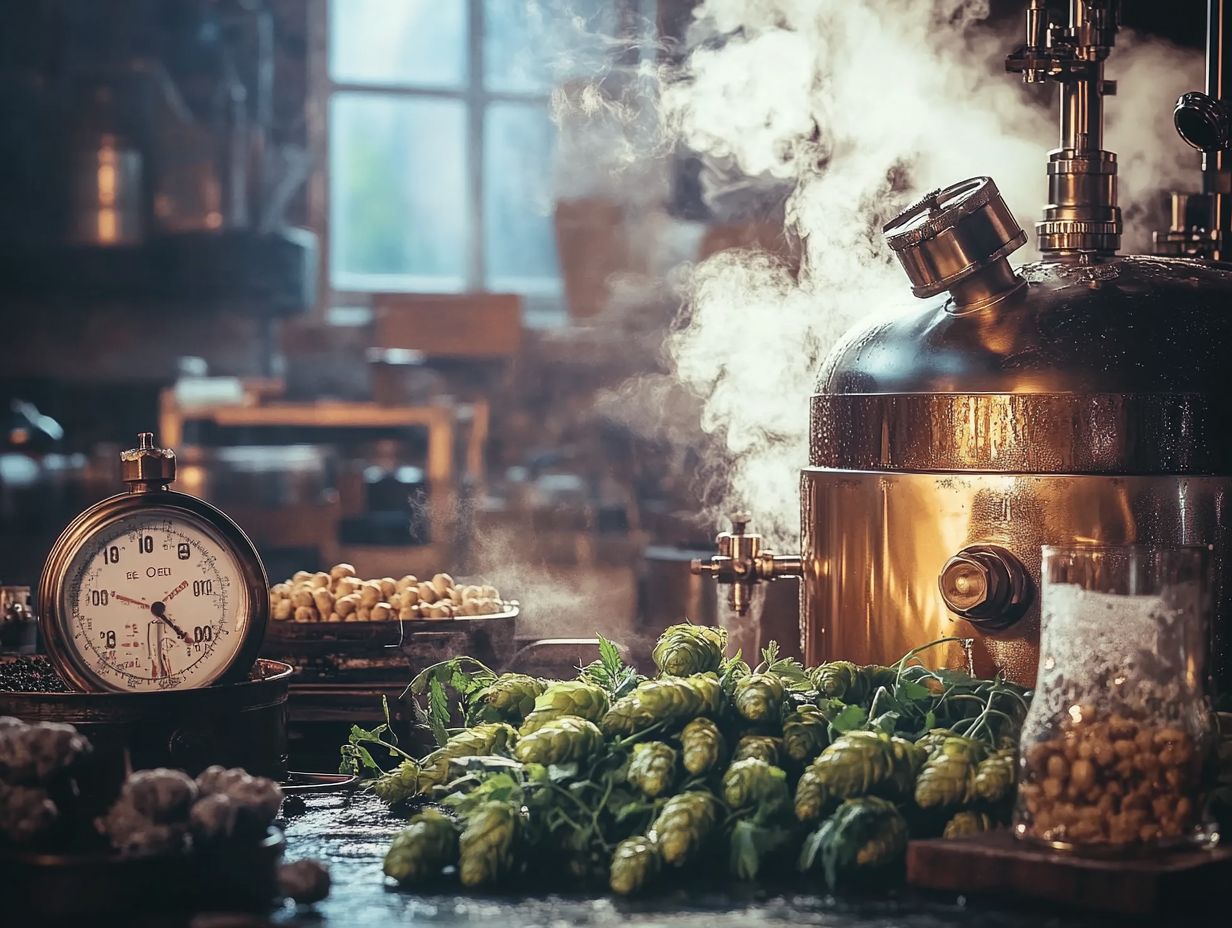
Keeping meticulous records of time and temperature is vital for your brewing success. It allows you to track your processes and make informed adjustments as needed. By regularly checking and documenting temperature readings during mashing and fermentation, you can ensure you stay within optimal ranges, effectively preventing off-flavors, unwanted fermentation reactions, and inconsistencies.
This practice not only assists in troubleshooting but also enhances your future brewing endeavors; after all, historical data can guide you toward better decision-making, whether you are adjusting the mash temperature or experimenting with hop aroma.
Establishing a structured system for record-keeping will give you the power to pinpoint any variations that could impact your final product, such as fluctuations in ingredient quality or changes in equipment performance. For instance, monitoring pH levels can help in maintaining the stability of your beer. A well-maintained logbook becomes an invaluable resource, helping you reflect on what worked and what didn t, thereby nurturing a culture of continuous improvement and refinement.
By embracing the discipline of record-keeping, you ll discover that your ability to replicate successful batches becomes significantly more reliable. This translates not just into better beer but also into a more gratifying brewing experience overall. Your attention to detail will also minimize the risk of DMS and other unwanted chemicals affecting the flavor profile of your beer.
Brewing Techniques: Practice and Experimentation
4. Practice and Experiment
Practicing and experimenting with various brewing techniques is essential for you to master the art of timing. Each batch provides a unique opportunity to refine your skills and discover new flavors. By making thoughtful adjustments to timing, temperature, and ingredients, such as exploring different malt types or water profiles, you can gain a deeper understanding of how these variables interact to influence the final product.
Embracing experimentation fosters creativity and innovation in your brewing. It also allows you to develop unique beer styles that truly reflect your preferences. You might create a craft brewing masterpiece like a Double IPA or a more traditional Pilsner, depending on your adjustments.
For example, adjusting the steeping time of grains can enhance the richness of your beer. Fine-tuning the boil duration can significantly alter its bitterness or sweetness. Exploring fermentation temperatures opens up avenues for you to delve into flavor development, enriching the overall aromatic profile of your brews. The use of specialized hop products, like LUPOMAX , can also add unique flavors to your creations.
Keep meticulous notes on each adjustment you make. This enables you to track what works and what doesn t, ultimately refining your craft. This journey of exploration contributes to your personal growth and adds to the collective knowledge within the brewing community. Interacting with brewing centers and participating in brewing science courses can further enhance your understanding and skills.
Frequently Asked Questions
What Is the Importance of Timing in Craft Brewing?
The timing of different stages in the brewing process plays a crucial role in determining the quality and taste of the final product.
How does the timing of mashing affect the brewing process?
The timing of mashing, which involves steeping the grains in hot water, affects the release of sugars and enzymes essential for fermentation. Proper timing ensures the right extraction of malt and proteins, contributing to the clarity and taste of the beer.
Why is it important to keep a consistent boil time during brewing?
Consistent boil time helps extract essential compounds from the hops, such as bitterness, aroma, and flavor, that contribute to the overall taste of the beer. It also aids in the reduction of unwanted chemicals like Dimethyl Sulfide (DMS) and in achieving the target alcohol by volume (ABV).
Does the timing of adding hops affect the taste of the beer?
Yes, the timing of adding hops, whether at the beginning, middle, or end of the boiling process, can significantly impact the bitterness, aroma, and flavor of the beer. Different hop varieties, like Cascade and Chinook, also play a role in these attributes.
How Does the Timing of Fermentation Affect the Alcohol Content of Beer?
The timing of fermentation plays a vital role in the alcohol content of beer. Both the duration and temperature significantly influence the final product.
Longer fermentation times and higher temperatures often result in increased alcohol levels. Accurate temperature control also helps prevent unwanted fermentation reactions, ensuring the desired Alcohol by Volume (ABV).
What Is the Importance of Timing When Bottling or Kegging Beer?
Timing is essential when bottling or kegging beer. It ensures that the beverage has reached its desired carbonation level and that flavors have fully developed.
Proper aging and monitoring of residual sugars are key to achieving a well-balanced final product. This process enhances your beer-drinking experience!





